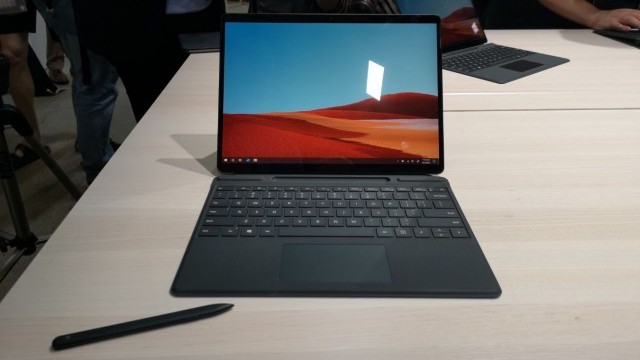Surface Pro X Reviews Are In: These Are the Biggest Problems
Microsoft dropped the ball

The first reviews of Microsoft's Surface Pro X are out and while the tablet has a lot going for it, reviewers generally agree that several limitations prevent it from living up to its potential.
To get you caught up, the Surface Pro X is Microsoft's newest Surface product. A detachable 2-in-1 like the Surface Pro 7, the 13.3-inch Surface Pro X has a modern, ultraportable design along with an ARM-based Microsoft SQ1 processor, a high-resolution display, LTE connectivity and a unique keyboard (sold separately) that holds a rechargeable stylus.
On paper, the Surface Pro X sounds like an intriguing device but the first batch of reviews agrees that the tablet is less than the sum of its parts. Why is that? We've put together a list of the complaints reviewers raised in their Surface Pro X reviews.
Here are all the things critics don't like about the Surface Pro X.
App compatibility issues
The Surface Pro X is powered by an ARM-based processor called the Microsoft SQ1. ARM processors have their perks but one serious limitation is that they can't run all programs. Specifically, the 64-bit ARM processor in the Surface Pro X can't run 64-bit x86 apps that were designed for Intel.
Fortunately, most apps are available in 32-bit versions, which the Surface Pro X can run via an emulator. But those programs don't always run as well as they should.
Dieter Bohn at The Verge noted these problems and gave an overview of what can and cannot run on the Surface Pro X but noted that determining exactly which apps are compatible can be an ordeal.
"Everybody has one or two apps they absolutely need to do their job," Bohn wrote. "With the Surface Pro X, there’s no real way to know if it will run well (or at all) without doing a ton of research ahead of time. Dropbox, for example, only works as an insular “S-Mode” app and can’t sync your files automatically.
Stay in the know with Laptop Mag
Get our in-depth reviews, helpful tips, great deals, and the biggest news stories delivered to your inbox.
Heck, even Microsoft’s own app store doesn’t properly filter out incompatible apps when you visit it from this computer," he added.
Sam Rutherford at Gizmodo dove into the performance hit you take when using an emulator to run 32-bit x86-based app. The numbers aren't pretty.
"For instance, when I ran the WebXPRT 2015 browser benchmark in Edge, I got a score of 372," Rutherford wrote. "But when I ran the test again in Chrome, numbers fell by nearly 40 percent to 226. Another good example of less than ideal performance is Photoshop in Adobe Creative Suite, which right now, doesn’t have ARM64 support."
"If you want to edit a photo, no problem, the Pro X can handle that just fine. But compared side-by-side against a similarly priced laptop, you can see when the Pro X is forced to render parts of the image in chunks or how trying to crop a photo feels a bit more sluggish," he added.
The New York Times' Brian X Chen ran into problems running the apps he uses on a regular basis.
"Another downside is that some important apps were not compatible with this ARM-based computer," Chen wrote. "Dropbox, the online storage service that I rely on every day for work, doesn’t fully function on the Surface Pro X. Adobe was still working to make some of its creativity apps, like Photoshop, work with this special version of Windows."
Bugs and poor performance
Compounding these app compatibility issues are performance problems some reviewers faced.
Cherlynn Low at Engadget ran into several problems while attempting to execute simple tasks on the Surface Pro X.
"Just as troubling as the limited app compatibility are the bugs I experienced, Low writes. "Barely a day after I started testing the Surface Pro X, it hung on me twice. The first time, I was trying to adjust the screen brightness and the panel stopped reacting. It refused to get brighter or dimmer, no matter if I was using keyboard shortcuts, the sidebar slider and or even display settings. I had to restart the Pro X to regain brightness control."
Not every reviewer had the same problems, and some even praised the Surface Pro X for having better-than-expected performance for a machine with an ARM-based chip. But the performance issues aren't isolated.
The Verge's Dieter Bohn says he SQ1 performed better than expected, but not perfectly.
"There are still occasional, confounding slowdowns, especially when waking from sleep. In general, I just didn’t have as strong a feel for what would and would not bog down this computer — with an Intel chip, I know what to expect," Bohn wrote. "But it wasn’t fast, certainly not as fast as an equivalently priced Intel device would be."
It's too expensive
Microsoft's products aren't cheap but they are typically worth the price premium. The Surface Pro X, however, is simply overpriced based on early reviews.
With the powerful Intel-based Surface Pro 7 starting at $749, it's no wonder so many reviewers are criticizing the Surface Pro X's $999 starting price. Yes, the Surface Pro X ships with a stylus, but the keyboard is sold separately and, at $139, it's not cheap.
Upgrading the Surface Pro X from the base specs — 8GB of RAM and 128GB SSD — raises the price exponentially. The 256GB model costs an extra $300 while the 16GB model with a 512GB SSD goes for a wallet-emptying $1,799. Oh, and that's without the keyboard.
Dan Ackerman at CNET listed several things the tablet does well — it has slim design, a great stylus, a nice display and decent battery life — but said that the price, along with a couple of other shortcomings, makes the Surface Pro X, "ideal for only a small subset of the tablet-toting population."
"The physical redesign is spot on, but diving deeper into the hardware specs and a confusing price structure, there's a lot that makes me scratch my head," Ackerman wrote.
Todd Haselton at CNBC had a lot of good things to say about the Surface Pro X. He likes the tablet's design, its gorgeous display and how easy it is to unlock via Windows Hello. But the price is hard to overlook. In fact, the headline of Haselton's review states the problem outright: "Microsoft has been trying to beat the iPad for a decade, and the Surface Pro X is close — but too expensive to recommend."
"Since it doesn’t run on a traditional Intel or Intel-compatible ARM processor, some of the apps you might rely on for work may not work," Haselton wrote. "Because of that, and the $999 starting cost without the $139.99 keyboard, I don’t expect this to fly off store shelves."
Brian X. Chen at the New York Times also had plenty of positive things to stay about the Surface Pro X and even considers it a "neat product" for people who "want to live at the bleeding edge of tech." But ultimately concluded that it's not for most people.
"At $1,000, the Surface Pro X is expensive. The keyboard and stylus, which are must-buys to get the most out of this tablet, drive the price up to $1,270. For that much money, you could get a great laptop and a separate tablet. For most people, that’s probably still the way to go," Chen wrote.
Keyboard sold separately
Complaints about the Surface Pro X's price and the keyboard being sold separately go hand-in-hand but it's worth highlighting a problem that nearly every reviewer mentioned. This wouldn't be an issue if the keyboard wasn't so expensive: $139 for the traditional Surface keyboard and $269 for the Signature Keyboard that comes with the Slim Surface Pen.
Cherlynn Low at Engadget argues that while the Surface Pro X costs as much as the iPad Pro, the optional keyboard attachment is a mandatory purchase to get the full experience of Microsoft's tablet. By not including it, Microsoft is doing a disservice to customers.
"Microsoft continuing to charge extra for the keyboard is basically deceptive pricing -- you won't want to use Windows on a tablet without it," Low wrote.
CNET's Dan Ackerman pointed out how the Surface Pro X is almost always shown with a keyboard, yet the accessory isn't included.
"But the biggest historical Achilles' heel of the Surface Pro family muddies the water. That excellent clip-on magnetic keyboard and the newly redesigned stylus don't come included in the box, no matter which configuration you buy," Ackerman wrote. "They're sold separately, even though I've never seen a Surface Pro, X or otherwise, in the wild or in a commercial, without them."
Miscellaneous complaints
The points listed above were mentioned across multiple reviews but some reviewers pointed out a few other issues they had with the Surface Pro X that prospective buyers should consider.
Sam Rutherford at Gizmodo noted that the Surface Pro X doesn't have a headphone jack, so you'll need an adapter to listen to music.
"While I really appreciate that Microsoft has finally embraced USB-C for its 2019 Surfaces, I’m not a fan of removing the headphone jack on something that’s supposed to be a laptop replacement. I also feel like Microsoft’s Surface Connect Port is a waste of space," Rutherford wrote.
And problem we've had with the Surface Pro tablet for years also seems to be an issue on the Surface Pro X. Todd Haselton at CNBC says that the kickstand on the back of the Surface Pro X doesn't offer the best experience when you're using the tablet on your lap.
"Finally, the Surface Pro X’s kickstand is still terrible if you want to use the computer in your lap. I felt like I was constantly trying to balance it."
Phillip Tracy is the assistant managing editor at Laptop Mag where he reviews laptops, phones and other gadgets while covering the latest industry news. After graduating with a journalism degree from the University of Texas at Austin, Phillip became a tech reporter at the Daily Dot. There, he wrote reviews for a range of gadgets and covered everything from social media trends to cybersecurity. Prior to that, he wrote for RCR Wireless News covering 5G and IoT. When he's not tinkering with devices, you can find Phillip playing video games, reading, traveling or watching soccer.

